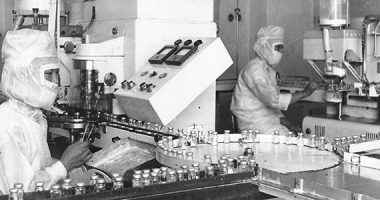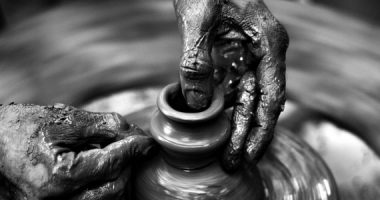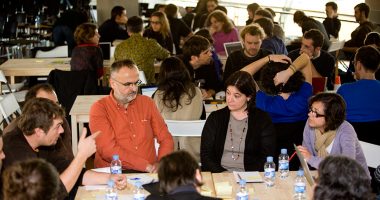
The mass spectrometer in the Seibersdorf laboratory of the International Atomic Energy Agency. IAEA, Austria. Source: IAI
The LABMeeting 2015 conference held at MediaLab Prado in late September brought together, for the first time, many of the projects and experiences that have helped to create and shape a lab culture in recent decades. The event in Madrid generated valuable material that is already available online and will be further discussed, processed, and enhanced over the coming months.
LABMeeting 2015 consisted of three high-intensity days organised with passion, knowledge, and immaculate care. The presentations, conversations, debates, and working sessions created an environment conducive to the free sharing of ideas and of projects steeped in a non-conformist spirit. There was a feeling of excitement at seeing the blossoming of seeds planted some time ago, along with the cultivation of imagination and perseverance, and the awareness of new territories that have not yet been definitively mapped. As such, LabMeeting 2015 fulfilled at least three of its main objectives:
- To develop an overview of the origins and development of “lab culture” in our context, in order to trace a genealogy that will help us understand to what point it is a new phenomenon.
- To gain a better understanding of the different models of cultural, artistic, technological and social “laboratories”, the underlying concepts, the strategies they use to carry out projects, the obstacles they face, and their achievements so far.
- To recognise the still largely ignored contributions of an experimental culture made up of artists, scientists, managers, and makers that took on the challenge of ongoing research and innovation.
What follows is a series of notes made before and after attending LabMeeting 2015, where each presentation was an effervescent node in an ecosystem made up of networks, processes, and platforms that are catalysts for change in our time.
What processes and dynamics have favoured the emergence and growth of LAB Culture?
- The process of questioning 20th century ways of conceiving, creating, producing and distributing knowledge, and the activation of a distributed network culture in which each node can potentially communicate with all other nodes.
- The effort to ensure issues that are crucial to the emergence of a new culture remain on the cultural agenda: the open source software movement, the debate around traditional copyright and intellectual property rights, models based on co-creation with users, the influence of expanded education, and so on.
- The reintroduction of the importance of the public sphere and the commons in debates around culture.
- The cultivation of collective intelligence, which does not reject individual intelligence but enhances and augments it.
- The calling into question of traditional ways of “prescribing” culture as a result of the emergence of new agents or “prescribers”, and the subsequent need to negotiate new, more flexible and democratic forms.
- The ongoing collaborative hybridisation of disciplines and know-hows, looking beyond the “two cultures” to a third, fourth, or fifth culture in which there essential connections have been made between the human and physical sciences.
- The reconciling of a “culture of diagnosis” (at which all of us can be adept) and a “culture of solutions” that advocates cultural practice as a necessary, crucial tool against the challenges arising from a multi-factor crisis: environmental, economic, political, ethical, etc.
- The focus on the new modi operandi required by cultural institutions, and on their approach to content creation, production, and programming.
- The increasing critical awareness of the use and abuse of new information and knowledge technologies, as can be seen in the rise, justification, and demystification of Web 2.0.
- The reactivation of a broad discussion on genres and formats, incorporating models from hacker culture and the discoveries and developments of contemporary art, as well as traditional genres and formats that are – apparently – still going strong.
- The gradual move towards a more open and evolved conception of audiences, which is perhaps one of the most radical and significant changes of the last decade.
- The introduction of the debate on who decides cultural policies, how they are conceived and constructed, and what actors are usually left out of the process of formulating and developing these policies.
- The expansion and augmentation of the traditional concept of education, with a view to continuous learning.
The present and future of LAB Culture
- Conferences such as LABMeeting 2015 and similar events held in cities around the world illustrate the strength and vitality of a creative, experimental, critical and self-critical spirit that needs to negotiate the dangers of “labification”, avoiding semantic fetishes and suspect appropriations.
- The existence of a diversity of models, styles, and methodologies does not stand in the way of identifying a series of points in common. This is a necessary undertaking: to define unifying factors and connecting patterns, not just the differences, errors, or contradictions of an open process.
- There is a need to disseminate, debate, and expand the body of theory that was gradually built up throughout the twentieth century, and that already includes a large bibliography of works written this century.
- To conceive lab culture, with all its history, diversity, and mutations, as one of the crucial engines of a new, freer and more democratic culture.
- Art, science, technology, design, humanities… There are many possible combinations and hybrids, but all of them seek to transcend the boundaries of “the two cultures” (C. P. Snow) and even some reductionist ideas around the “the third culture”.
- The gradual development and maturing of a culture based on risk and experimentation is something that we need to “care for”, “curate”, consolidate and open up without dogmas or exclusive reserves.
- Lab culture can be generated from the margins and the periphery, but it can also spring from cultural institutions (universities, schools, museums, libraries, etc.).
- Lab Culture has its own indisputable pioneers and influences, but also new expressions that have sprung from and continue to develop through its own experiences and practices, which include totally new aspects.
- Lab Culture is a particular position in relation to the conception, creation, production, and distribution of knowledge in the twenty-first century. It is a spirit that “blows wherever it pleases” and may turn up in the most unexpected spaces, groups, and institutions.






Leave a comment